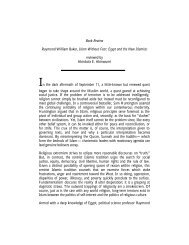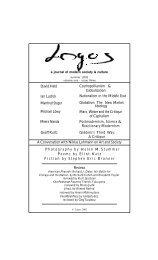Michael J. Thompson Stephen Eric Bronner Wadood Hamad - Logos
Michael J. Thompson Stephen Eric Bronner Wadood Hamad - Logos
Michael J. Thompson Stephen Eric Bronner Wadood Hamad - Logos
Create successful ePaper yourself
Turn your PDF publications into a flip-book with our unique Google optimized e-Paper software.
Abbas Amanat<br />
vague qualifications. His wilaya, in theory at least, could be extended to any<br />
jurist and not the one that is publicly recognized as the most important<br />
marja’ or even a mujtahid. Such definition no doubt served Khomeini well<br />
while languishing in the exile of Najaf away from his constituency.<br />
As defined by Khomeini, the doctrine of the “guardianship of the jurist” was<br />
applicable to public law as well as civil law. In the absence of the Hidden<br />
Imam, he argued, the jurist presents the least oppressive form of authority<br />
because contrary to temporal rule it is founded on Islamic principles. The<br />
jurist is the most qualified in matters of law, which according to Khomeini is<br />
inherently superior to any secular body of law, and he is obliged by the same<br />
Islamic legal principals to uphold and enforce it. It is therefore incumbent<br />
upon the jurist, as an “individual duty” to strive for acquiring political<br />
authority in order to form the Islamic government. Khomeini’s doctrine was<br />
a revolutionary interpretation of the authority of the jurist even though he<br />
tried hard in his wilayat-i faqih (later Hukumat-i Islami) to fortify his theory<br />
with precedent from classical legal texts and citations from such Usulis jurists<br />
as the 19th century Mulla Ahmad Naraqi. No Shi’ite jurist before him ever<br />
extended the very limited application of legal wilaya to include public affairs,<br />
let alone, assuming of political power.<br />
Legal articulations aside, Khomeini’s doctrine was driven by the requirements<br />
of his constituency. Not only a young generation of his students and<br />
followers defied the legitimacy of the Pahlavi shah, and whatever he stood<br />
for, but they aspired coherence and unanimity within clerical ranks. The<br />
wilayat-i faqih promised not only the ascendancy of the jurists to positions of<br />
political power but a virtual end to clerical resistance to institutionalization.<br />
The rise of the wilayat-i faqih as an institution harbinger the eclipse of the<br />
marja’iya and all the ambiguity that was inherent in qualities of the mujtahid.<br />
Assuming political power by Khomeini and his ’ulama backers, which came<br />
with the revolution of 1979, inevitably imposed a bureaucratic regime on the<br />
Shi’ite ’ulama more rigid than the chaotic madrasa system of Najaf and Qum<br />
ever did. Even the honorary clerical titles, inflated over time, gained new<br />
hierarchical connotation. While ayatollah (a sign of God) applied to the<br />
higher clerical figures, the hujjat al-Islam (a proof of Islam) signified the rank<br />
below. The highest status however was Khomeini’s own. As the “guardian<br />
jurist” (wali-yi faqih) he assumed the title of imam, first time ever used in the<br />
history of Shi’ism in a context other than the twelve Imams. Although the<br />
office of guardian jurist was considered the one and the same as the “deputy<br />
<strong>Logos</strong> 2.3 – Summer 2003




